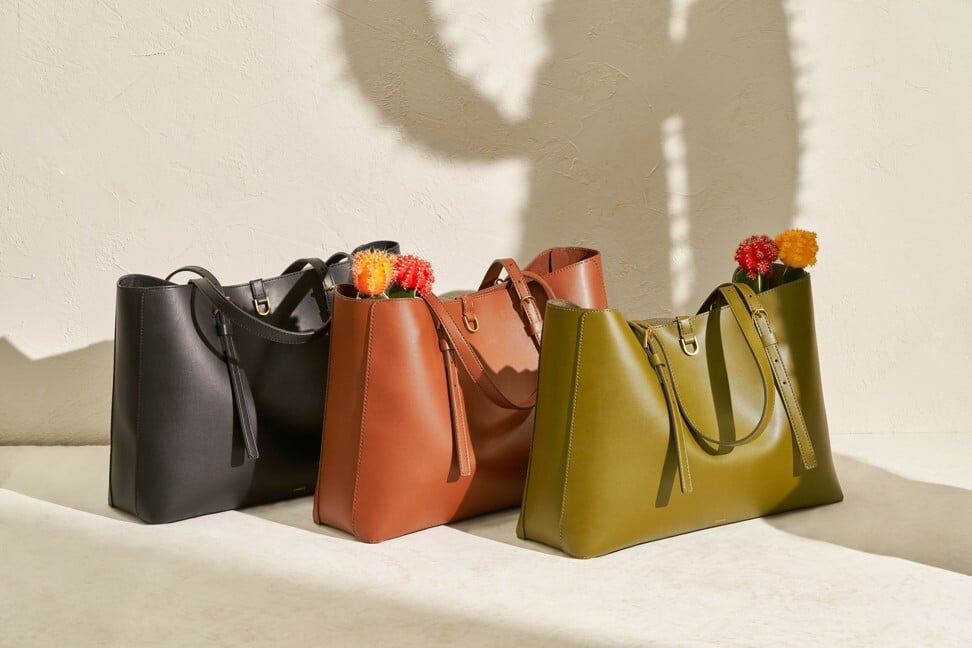
Shoes made from grapes, bags made from mushrooms: vegan leather has fans in Hermès and other fashion brands, but alternatives to hide have their drawbacks
- The tanning process that turns animal skins into usable and wearable leathers has regularly been slammed as wasteful and potentially toxic
- Vegan alternatives to hide leather exist, but one industry insider says they are ‘not there yet’ in terms of hand feel, breathability and appearance
Pineapple leaves, fungus fibres, sugar cane, cactus: all botanical elements used in the production of various kinds of plant-based leather. Inspired by the environmentally sustainable thinking now sweeping the world, these so-called vegan leathers have become increasingly popular alternatives to hide leather.
“I think anything that’s an alternative to traditional leathers is probably worth exploring, because of all the issues we have with industrial cattle farming, and then with tanning and all the challenges there,” says Edwin Keh, chief executive officer of the Hong Kong Research Institute of Textiles and Apparel.
Cattle raising for beef, milk or leather is one of the largest contributors to greenhouse gases, and considered inhumane by some, and the tanning procedures used to transform animal skins – mostly cattle hides – into usable and wearable leathers have regularly been slammed as wasteful and potentially toxic.

“In the short term, the more ready-for-market are the more rigid applications, so if you’re making boxes or bags, these are probably ready to go, but the softer applications – apparel and footwear – are probably not there yet.”
5 sustainable sneaker brands selling cool shoes at good prices
US-based Fossil’s new Kier bag, using a material from cactus leaves, has already hit the shops in Hong Kong. Steve Evans, executive vice-president and chief brand officer, says Fossil customers were looking for increased diversity, “especially more eco-friendly materials”, so a bag made from organically grown cactus was a natural fit. Produced by Desserto, in Mexico, the cactus-based leather in three colours worked for Fossil’s new range of totes.
“Many of our customers are looking to make more sustainable changes in many or all areas of their lives – including their fashion purchases,” he points out, adding the Kier bags (which retail for US$298) are as durable and perform as well as traditional leather bags.

Plant-based leathers, or vegan leathers, or bio-leathers (as they are sometimes known) are not made from animal skins, but they are not all equally environmentally sustainable.
Some require greater amounts of water to produce, some are based on botanical waste rather than crops grown especially, some incorporate less degradable synthetic fibres to enhance the material’s structure.
It can be difficult to weigh the different elements to understand a product’s relative sustainability, and the products can be difficult to work with.

A lifelong vegetarian and conservationist, McCartney has in the past used a product called Alter-Mat, formerly Alter-Nappa, a faux leather made from a combination of polyester and polyurethane.

As consumers become increasingly concerned about global warming and climate catastrophes, and about the mountains of plastic waste in the oceans and the toxins in water and airborne pollution, more sustainable plant-based products have begun to move into the mainstream.
Research institute CEO Keh says the shift away from traditional hide leathers is inevitable, and will be part of a “more comprehensive solution”. He says: “I think there are opportunities to do more lab-grown leather-like materials, protein-based leather. And there are a lot of opportunities for different types of recycled content, and then plant-based is probably also one of the solutions.”
There is work under way on a protein-based solution using recycled leather, he says, and notes that leather has been recycled in various ways for a long time. “The most common form is ground-up leather on a polyurethane scaffolding,” he says. “The trouble is you make matters worse, because now you have a polyurethane/leather material that is incredibly hard to recycle or reuse because it’s petroleum-based as well as leather-based. Then the adhesives means you have all sorts of chemical toxins that you also have to deal with.”

The research institute he runs has gone in a different direction. “We are trying to create protein-based solutions, using things like silk and wool as scaffolding, and natural protein-based binders to hold everything together,” Keh says. “A completely natural and mono material.”
The sheer availability of plant-based leathers can be a problem for manufacturers. The products haven’t yet been made on an industrial scale, and Keh says their pricing has not been worked out sufficiently yet to make plant leathers an affordable alternative.
“I think everybody is looking for an alternative because of the recognition of all the problems with the manufacturing and production of leather, the state of the art as it is today,” he says. “I think if you look at more synthetically produced or artificially produced leather-like materials, the advantages are obvious. They’re much easier to cut, they’re more regular shaped, so you have a much improved yield, and they are approaching the aesthetics of leather.”
